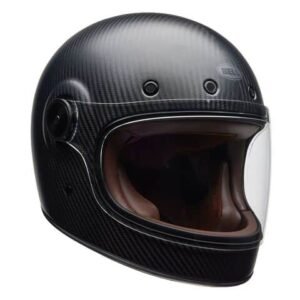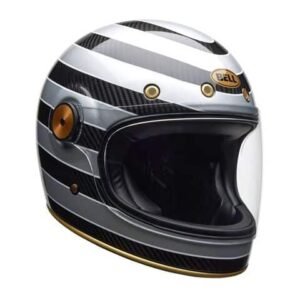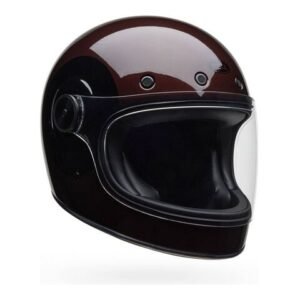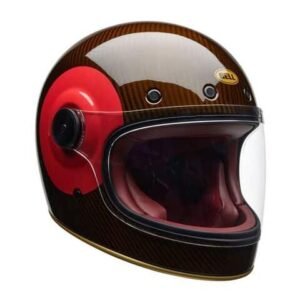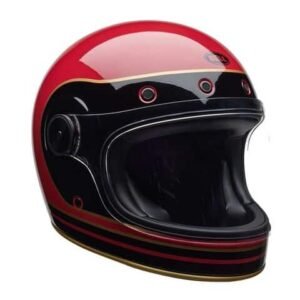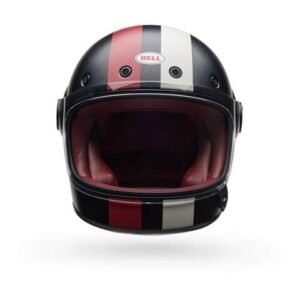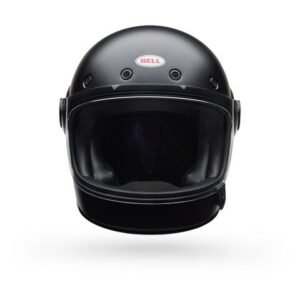This Bell Bullitt GT Review reveals why this retro full face helmet continues dominating the vintage motorcycle scene a decade after its debut.
Bell’s engineers spent years collecting real-world feedback from Bullitt owners to address the original’s limitations while preserving its character.
The GT features closable forehead vents, tool-free visor removal, and improved interior comfort that makes it more practical for daily riding.
But does the Bullitt GT justify its premium price tag, or should you consider alternatives in today’s crowded retro helmet market?
What I Like and Dislike
What I Like About the Bell Bullitt GT
I love the retro aesthetics—this helmet stands out as the best-looking classic lid I’ve ever worn. The style stays true to the original Bell Star, and I get compliments on the look every time I ride.
I enjoy the customization options, from the ten colorways to the black, brown, or red leather interiors and the ability to swap out shields.
The ECE 22.06 certification gives me real peace of mind, and the helmet feels sturdier than older models. The quick-release visor system makes cleaning and switching shields easy, which I really value on longer trips.
The GT is lighter than a lot of other ECE helmets, so my neck doesn’t get tired, even after hours on the bike. I find the closable forehead vents work well for rain and chilly mornings.
As someone who wears glasses, I appreciate how comfortably they fit inside. The removable liner and antimicrobial interior make maintenance simple.
I use the wide field of view to stay aware in traffic, and it genuinely makes me forget I’m wearing a helmet sometimes.
What I Dislike About the Bell Bullitt GT
I’ve struggled with the fit—my chin sometimes presses against the internal vent switch, which can feel claustrophobic. I had to size up from my usual medium to a large, and even then, the cheek pads don’t always give me the perfect fit.
The wind noise is a real drawback; it’s louder than my Arai or Shark, and I notice a lot of whistling at speed, especially above 40 mph.
I’ve tried adding velcro strips to seal the gap at the top of the visor, but it’s still not as quiet as I’d like. The lack of a Pinlock-ready shield means I deal with fogging in cold or wet weather.
I’ve also noticed the collar flexes a bit if I squeeze it, which makes me wonder about long-term durability. I miss the chin vent from older models—airflow isn’t as good on hot days.
The carbon version’s price feels steep for the small weight savings. I’ve seen scratches appear above the visor from regular use, which is disappointing for a helmet at this price point.
Full list of specifications:
- A premium retro option with leading safety and performance
- Updated shield mechanism, shield gasket, vent system, liner and fit (versus outgoing model)
- Ultra slick, low-profile fiberglass composite shell
- 3 shell sizes
- SM: XS and SM Helmets
- MD: MD and LG Helmets
- LG: XL and 2XL Helmets
- Revised face shield hinge mechanism for better seal
- Rubber face shield gasket added for improved wind and noise isolation
- Shield changes are now toolless – just press and slide
- Rotated head form and updated sizing for improved fit
- Updated interior for easy maintenance
- Revised, closeable brow / forehead ventilation system:
- 5 metal mesh vents – all controlled by a single slider
- Closeable via convenient thumb slider at chin bar
- Single, large rear exhaust port
- Enlarged eye port for an unmatched field of vision
- Multi-density EPS liner
- Clear, flat-style face shield included
- Available tinted and vintage bubble shield accessories sold separately
- Perforated micro-suede interior fabric with leather trim
- Removable, washable and anti-bacterial interior
- 3D cut cheek pads with speaker pockets
- Padded chin strap with stainless steel D-Ring closure with leather pull tab
- Magnefusion shield closure system
- Industry-leading five-year warranty
- DOT and ECE 22.06 certification
Note: Helmet ships with clear face shield only.
Shell Construction
The Bullitt GT is built with a composite fiberglass construction that uses 42% fiberglass material in its outer shell. This creates a narrow silhouette that maintains its compact form across all head sizes from XS to XXL.
It features three different shell sizes to accommodate this range while keeping that classic retro profile intact.
The carbon fiber version takes a different approach. The shell is constructed by the GT Carbon with 40% carbon fiber material, which provides a sturdier build quality compared to the standard fiberglass model. When I hold both versions, the carbon variant feels more solid and rigid in my hands.
The pricing reflects these material differences. Standard Bullitt GT models range from $434.99 to $454.99, while carbon versions cost $614.99 to $634.99. You’re paying about $180 more for that carbon construction.
I was able to flex the entire collar of the helmet by about an inch on both sides when pressing inward. It has a “thin wall” construction, which raises questions about the shell’s rigidity under impact conditions.
Aerodynamics
The lid is designed with a smooth, rounded shape that allows air to flow around it without creating major turbulence at highway speeds.
The shell includes a subtle exhaust cut-out at the back – the only modern aerodynamic feature on an otherwise retro design.
However, the Bullitt GT makes no pretense about being an aerodynamic full face helmet. They didn’t design this lid to eliminate buffeting or create negative lift at speed.
The aerodynamic limitations become apparent quickly when you push past city speeds. While the smooth shell prevents major buffeting, the overall design prioritizes classic aesthetics over wind-cheating performance. If you’re planning long highway rides or track days, you’ll want to look at more aerodynamically refined options.
Bell Bullitt GT Sizing
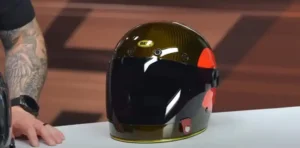
The Bell Bullitt GT is designed with three distinct shell sizes that span the XS to XXL range, ensuring proportional fit across different head measurements.
It uses their updated sizing chart, though I’ve noticed you might need to go up one size from your typical measurement. When I measured my head at 58cm, the medium fit spot-on according to Bell’s sizing guide.
They have addressed previous sizing complaints by rotating the head form and updating the internal dimensions.
I typically wear a 58cm but had to go up to large from my usual medium. The helmet now accommodates spectacles much better than previous versions, which I can confirm from personal testing.
Fit and Head Shape
The lid shape is engineered with an intermediate oval head shape that represents a major improvement over the original Bullitt’s round oval design.
The update eliminates the previous version’s tendency to create pressure points around the forehead while maintaining snug contact around the crown.
The GT works well for riders who struggled with the original Bullitt’s fit characteristics. My previous Bell full face helmets caused jaw tension, but the GT’s contact point sits further back near my jaw joint, eliminating that pressure.
The revised shape provides snug crown contact while allowing a comfortable side-to-side fit. This intermediate oval design works for riders who found the original Bullitt too loose around the temples or too tight across the forehead. They rotated the head form based on extensive rider feedback to achieve this more universal fit.
However, the helmet still won’t suit every head shape. The original Bullitt’s “Buzz Aldrin” shell concept meant it never achieved race helmet tightness, and some of that character remains in the GT.
Those people with long oval head shapes may still find better options elsewhere, though the intermediate oval design opens up compatibility for many who couldn’t wear the previous version.
Head Size Chart
| Helmet Size | Head Circumference (cm) | Head Circumference (inches) | Hat Size (inches) |
|---|---|---|---|
| XS | 54-55 | 21 1/4 – 21 5/8 | 6 3/4 – 6 7/8 |
| Small | 55-56 | 21 5/8 – 22 | 6 7/8 – 7 |
| Medium | 57-58 | 22 1/2 – 22 3/4 | 7 1/8 – 7 1/4 |
| Large | 58-59 | 22 3/4 – 23 1/4 | 7 1/4 – 7 3/8 |
| XL | 60-61 | 23 5/8 – 24 | 7 1/2 – 7 5/8 |
| XXL | 62-63 | 24 1/2 – 24 3/4 | 7 3/4 – 7 7/8 |
Shell Size Distribution
| Shell Size | Sizes Included |
|---|---|
| Small Shell | XS, Small |
| Medium Shell | Medium, Large |
| Large Shell | XL, XXL |
Bell Bullitt GT Interior

The interior is equipped with antimicrobial PU leather and suede which represents a major upgrade from the original Bullitt’s Alcantara lining.
The synthetic leather trim runs around the visor aperture and helmet bottom, while the rest uses a soft, comfortable fabric that feels plush against your head.
The interior padding can be removed easily for hand-washing, which I’ve done several times without any deterioration in quality.
They designed the lining with antimicrobial properties to manage sweat and odor during long rides. The fabric maintains its softness even after multiple wash cycles.
Padding
It comes with multi-density contoured cheek pads that come in different thicknesses depending on your helmet size.
The cheek pad system allows for fit customization through interchangeable padding options.
| Helmet Size | Standard Cheek Pad Thickness |
|---|---|
| XS | 35mm |
| Small | 30mm |
| Medium | 30mm |
| Large | 25mm |
| XL | 30mm |
| XXL | 25mm |
Replacement cheek pads cost $22.99 and come in black or brown to match your interior color. You can adjust the fit by going thicker for a tighter feel or thinner for more room.
I’ve found the 30mm pads in my medium helmet provide the right balance of snugness without pressure points.
The brow mount system eliminates snaps at the forehead, preventing the pressure points that plagued earlier Bell helmets.
The GT’s cheekpieces fit better than previous versions. The padding breaks in over time, molding to your facial structure for improved comfort during extended riding sessions.
Bell Bullitt GT Ventilation
The four forehead vents now close via an easy-to-operate trigger system located on the lower left side of the chin bar.
Opening these vents creates a cooling breeze across your forehead that flows to the rear exhaust port.
Wire mesh over the forehead intakes prevents bugs from entering while maintaining airflow. I’ve found this system works well at highway speeds but provides limited cooling at low speeds around town.
They removed the chin vent from the original Bullitt after CFD analysis showed it wasn’t providing useful airflow.
The GT relies on the large open space around the chin bar to allow air movement. You can crack the face shield open slightly for additional airflow, and tucking the face shield tab maintains this cracked position.
The rear exhaust vent pulls hot air out through the Venturi effect, though the ventilation system can’t match modern sports helmets.
It gets quite warm behind the visor during stop-and-go traffic since the air doesn’t blow up across your face from the chin area.
Mesh backing in the interior helps exhaust air down the bottom of your neck, but overall ventilation remains limited compared to more modern designs.
For maximum airflow, I sometimes ride with the shield up and sunglasses underneath, which works fine given the helmet’s retro style and large eye port opening.
Bullitt GT Visor

It comes equipped with a clear face shield that delivers an outstanding eye port opening and field of view. The massive viewport makes you forget you’re wearing a helmet at all, providing unrestricted vision that surpasses even open-face designs when you factor in goggle restrictions. I’ve never experienced such panoramic visibility in any lid before.
Visor Features
It features a revolutionary tool-free visor removal mechanism representing a major upgrade over the original Bullitt.
Simply press the central button on the side covers and slide them back to remove the face shield. The visor pops securely back in place when reinstalling, creating a secure connection that prevents overtightening.
The GT features a redesigned gasket around the shield aperture that creates a tighter seal compared to previous versions.
This secondary wiper blade along the outside helps reduce wind noise and prevents water from running down the inside when the visor is closed. The magnetic closure system keeps the leather tab from flapping during riding.
You can crack the visor open slightly for increased airflow, and tucking the tab under the shield maintains this cracked position.
The first stage opens about 7cm and stays stable up to highway speeds before reaching the fully open position.
| Visor Position | Stability | Airflow |
|---|---|---|
| Closed | Stable | Limited |
| Cracked (with tab) | Stable to 40mph | Moderate |
| First stage (7cm) | Stable to highway speeds | Good |
| Fully open | Stable at any speed | Maximum |
The visor’s field of view is good but it has some limitations. The shield tends to shake when in the first stage due to buffeting from the bike’s screen, which becomes noticeable with a clean visor and obvious when flies are stuck to it.
The GT doesn’t use the same visors as the original Bullitt, and replacement shields aren’t widely available yet.
The original Bullitt visors cost $39.95 for clear, smoke, and colored flat or bubble options, so I expect similar pricing for GT replacements.
Despite an anti-fog coating, the visor mists up more readily than helmets with Pinlock systems, though no Pinlock option exists for this large eye port.
I have some durability concerns with scratches appearing above the visor from repeated opening and closing.
The magnetic closure system works well but isn’t as secure as sport helmet mechanisms. One of our team’s visors flips up when turning their head beyond 45 degrees due to airflow, though I haven’t experienced this issue during my testing.
The shield seals well along the top when closed, preventing water intrusion during wet weather riding. The open-face capability remains intact – plastic covers replace the visor if you want to ride with goggles, though the strap isn’t retained so you’ll need silicone grips.
Bell Bullitt GT Noise Levels
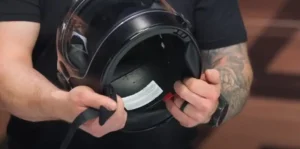
It is inherently a noisier helmet than modern sport lids due to its retro open-face design philosophy. The large chin opening that gives this helmet its classic character also creates the primary source of wind noise complaints from riders.
At highway speeds, air rushes in under the helmet where you won’t find a chin curtain or wind deflector.
This generates substantial wind noise that becomes annoying after extended riding sessions. The relaxed fit compounds this issue – the helmet tends to move around on your head rather than staying stable in the wind.
Wind Noise
It comes with a massive face opening that allows air to rush in around your chin bar area, creating wind noise that becomes noticeable after extended riding sessions.
The exhaust vent introduces wind noise at around 30-40mph, though this tends to disappear at higher speeds.
I’ve experienced this myself – it’s less of a whistling sound and more of a gentle buffeting that you notice once you start listening for it. Opening the visor stops the noise, as does covering the exhaust with your hand.
The GT is noisier than competitors and comes with acoustic sacrifices. Bell added a gasket to the rubber seal around the viewport to create a tighter seal, which theoretically reduces wind noise. The closable forehead vents also help when you want to minimize noise during highway riding.
Noise Reduction Tips
For most riders, quality earplugs solve the noise issue while preserving the helmet’s classic character.
I’ve found that modern filtered earplugs allow you to hear traffic and your bike while cutting the harsh wind noise that makes long rides fatiguing. The GT’s comfort and outstanding field of view make it worth the extra step of ear protection.
Bell Bullitt GT Safety Certification Standards

The Bell Bullitt GT is certified under both ECE 22.06 and DOT standards, representing a major safety upgrade over the original Bullitt that only carried DOT certification.
The GT passes all requirements for both certifications in a single shell design, eliminating the need for separate regional variants that plagued previous Bell helmets.
Exterior changes have been added to meet the stricter ECE 22.06 requirements, which include more rigorous impact testing, rotational impact assessment, and visor retention standards.
They are addressing previous certification concerns with the GT. The dual certification opens up the helmet to riders in Europe and other regions where ECE standards are mandatory.
I like that Bell took the time to properly certify the GT rather than rushing a new helmet to market. The ECE 22.06 rating addresses longstanding concerns about Bullitt’s safety credentials, making it a viable option for riders who prioritize both protection and classic motorcycle aesthetics.
Bell Bullitt GT Weight
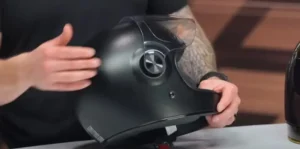
Bell claims 3 lbs 3 oz (1,450g) for medium fiberglass and 2 lbs 15 oz (1,352g) for medium carbon, though actual weights can vary by up to 50g.
When I weighed my size large fiberglass GT on digital scales, it came in at 3 lbs 2 oz (1,434g) – lighter than Bell’s claimed specification.
The weight reduction from carbon construction costs about $230 more than the standard version. Bell prices the fiberglass GT at $545 while the carbon model runs $775.
That 4-ounce difference becomes noticeable during extended riding sessions, though both versions remain competitive within their class.
The GT carries more weight than the original Bullitt, which weighed 2 lbs 13 oz (1,280g) in carbon and 3 lbs 2 oz (1,426g) in standard form.
The weight increase stems from new safety standards that required additional shell reinforcement and updated interior padding systems.
The carbon fiber construction provides the same protection as fiberglass while reducing fatigue during long highway riding.
Modern riders who prioritize weight savings will find the carbon GT competitive with other retro helmets, though it can’t match dedicated sport lids.
The aerodynamic shell shape reduces wind resistance at speed, making the actual weight less noticeable than the numbers suggest.
Bullitt GT Bluetooth Options
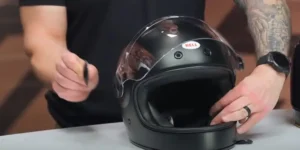
The Bullitt full face helmet is designed with integrated speaker pockets that accommodate most modern Bluetooth systems while maintaining the helmet’s classic lines.
The pockets measure 52mm in diameter and 12mm deep, providing ample space for speakers from popular brands like Sena, Cardo, and Scala Rider.
Bell built these speaker recesses larger than typically needed, which future-proofs the helmet for next-generation communication gear.
The 50mm size accommodates current systems with room to spare, making installation straightforward for most riders. I’ve installed Sena units in my GT with no fitment issues.
The helmet provides plenty of space on each side to mount the main intercom unit, though cable routing requires some planning.
The bonded-in neck skirt means you’ll need to run the speaker cable over it or forward under the cheek pad before tucking it in. I found running the cable forward works better for a clean installation.
I wish they made a drop-in Bluetooth headset system specifically for these helmets. It has spaces on each side for speakers but couldn’t find anything online specific to the Bullitt series.
I love listening to music on certain rides, but adding an intercom to the GT doesn’t sit right with me – I want to keep those classic lines intact.
Modern Bluetooth systems are installed cleanly in the GT’s speaker pockets without compromising interior comfort.
The leather interior and contoured cheek pads accommodate the gear well, though you’ll need to be mindful of cable placement during installation.
The design allows you to ride without the intercom system and add it later if needed. The speaker pockets remain hidden under the cheek pads when not in use, preserving the vintage look that makes the GT special.
Color Options
The Bell GT is available in ten distinct colorways that showcase Bell’s mastery of helmet finishing and graphics application.
The series offers both solid colors and graphic designs across standard fiberglass and carbon versions, each paired with leather interior options in black, brown, or red.
They produce the standard GT in plain gloss black, blue, green, and matt black for $545, while graphic versions like the ‘Wander’ model cost $570.
The carbon GT starts at $770 for solid colors and reaches $795 with graphics. I’ve seen the ‘Wander’ style in person – the off-white and black stripes sit beautifully under the gloss topcoat with seamless application.
The GT series includes special editions like the TT model in gloss red and gold, which honors Bell’s racing legacy.
Each helmet comes with a clear flat shield installed, plus an additional flat dark smoke shield on certain models. Bell offers 15 different shield styles including flat and bubble options, creating 150 total variations when combined with the ten base colorways.
I love the look of their GT, though my brother-in-law doesn’t appreciate the retro style. The helmet’s vintage appeal polarizes riders – you either embrace the classic motorcycle culture it represents or prefer modern sports helmet designs.
Bell finishes each GT with leather trim around the visor aperture and helmet bottom, though the thin split leather bonded to fabric rather than thick, full-grain hide.
The interior leather color coordinates with the exterior style – black interiors pair with most colorways, while brown and red options complement specific graphic schemes.
| Version | Price Range | Weight | Interior Options |
|---|---|---|---|
| Standard Colors | $545 | 3 lbs 5 oz | Black, Brown, Red |
| Standard Graphics | $570 | 3 lbs 5 oz | Black, Brown, Red |
| Carbon Colors | $770 | 3 lbs 1 oz | Black, Brown, Red |
| Carbon Graphics | $795 | 3 lbs 1 oz | Black, Brown, Red |
The carbon editions create what I would call a “mouth-watering and eye-watering” appeal – stunning to look at but expensive to own.
The carbon weave shows through the clear coat on solid models, while graphic versions overlay designs on the carbon base.
Both carbon and standard versions maintain the same classic proportions and retro character that defines the Bullitt legacy.
They deliver graphics that I would describe as “absolutely dope,” with color choices that represent some of the best work in the helmet industry.
The range spans from understated solid colors for daily riding to bold graphics that make a statement about your motorcycle culture appreciation.
Frequently Asked Questions
Should I size up from my normal helmet measurement?
My head measures 58.5cm which puts me right between medium and large according to their sizing chart, but I’d recommend trying the helmet on first.
How can I reduce the wind noise on my Bullitt GT?
It creates wind noise through a 2mm gap at the top of the visor that forms a venturi effect. I can fix this by adding a velcro strip above the gasket to seal the gap, which eliminates most of the horrible wind noise at speed.
What’s the weight difference between carbon and fiberglass versions?
The carbon version weighs approximately 1350g (2 lbs 15 oz) in medium while the fiberglass version weighs around 1450g (3 lbs 3 oz).
Both versions gained weight compared to the original Bullitt due to new ECE 22.06 safety standards, with the carbon increasing from 1280g and the standard from 1426g.
How well does the ventilation work on long rides?
I found it achieved a 0-degree temperature difference between inside and outside, earning four stars for ventilation performance.
It uses four vintage top vents that stay true to the original design while managing temperature effectively during road tests.
Does the visor mechanism work better than the original Bullitt?
The GT features a tool-free visor removal system that prevents over tightening and feels more secure than the original three-position mechanism.
The visor provides a massive field of view that makes me forget I’m wearing a helmet, though some users report it can flip up when turning my head beyond 45 degrees.
Is the Bullitt GT comfortable for all-day riding?
It features removable multi-density EPS liners and customizable cheek pads for a highly customizable fot. I used it for a month on my BMW R1250GS and found the massive field of view made him forget he had a lid on, though it’s not designed as a touring helmet.
What safety certifications does the Bullitt GT have?
The Bullitt GT meets both ECE 22.06 and DOT certification standards, addressing previous concerns about the original Bullitt’s limited certifications. This dual certification makes it legal for riders in Europe and other regions where ECE standards are mandatory.
Can I install a Cardo Packtalk or other intercom system?
The helmet has large speaker pockets and plenty of space on the sides for mounting intercom units. One YouTube user successfully installed a Cardo Packtalk Slim, though cable routing requires careful planning due to the bonded neck skirt design.
How does the noise level compare to other helmets?
We measured the Bullitt GT at 99 dB average, which puts it on par with heavy-duty touring helmets and earns four stars for noise isolation.
Its relatively noisy compared to sports helmets, but this is expected given the retro design with its large chin opening.
Is the Bullitt GT worth the price for retro styling?
I must admit you can get more versatile helmets for less money, but they have the proportions nailed perfectly.
Performance Summary
This Bell Bullitt GT helmet review reveals a lid that prioritizes classic motorcycle aesthetics over pure functionality.
You get a helmet that looks stunning with its retro style and massive field of view, but you’ll need to accept some compromises.
The GT weighs 3 lbs 2 oz in size large fiberglass and delivers ECE 22.06 plus DOT certification, making it legal worldwide while maintaining those vintage proportions.
Modern Safety Meets Classic Design
You’ll find the GT offers real improvements over the original Bullitt with closable forehead vents and a tool-free visor mechanism.
The helmet meets current safety standards while keeping that iconiclook intact. But you’re still getting a helmet that’s louder than modern sports lids due to the large chin opening, measuring around 99 dB on noise meters.
Comfort and Fit Considerations
You can expect a comfortable fit with the GT’s intermediate oval head shape and customizable cheek pads.
The helmet works well with glasses and features removable leather-trimmed interior padding.
Riders report the massive eye-port makes you forget you’re wearing a helmet, though some need to size up from their usual measurement.
Value and Recommendation
You’re looking at $545 for the standard version or $770 for carbon, which puts this helmet in premium territory.
The GT makes sense if you prioritize style over pure performance and understand its limitations at highway speeds.
This Bell Bullitt GT helmet review shows you get a helmet bought with the heart rather than the head – and that’s exactly what they intended.
